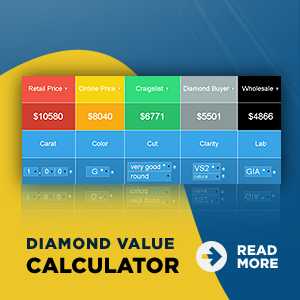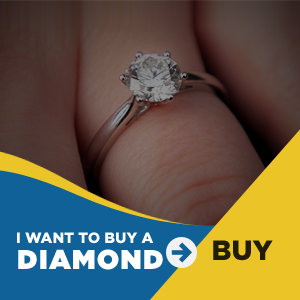On the matter of quality and thus the value of a cut diamond, the criteria are known as 4Cs they are Color, Clarity, Cut and Carat. Obviously, it helps to have apparatus like spectroscopes and spectrophotometers, stereomicroscopes, electric balances and also proportionscopes, but a knowledge of a basic technique enables a fairly accurate assessment of a diamond to be made with nothing more than a 10k loupe and the human eye.
Color-the point of color grading is to mark the degree of deviation from whitest possible stone down to the yellowest which is still acceptable as being of gem quality. There are a number of grading systems in use, but the most widely accepted internationally has become that of the Gemological Institute of America(GIA). Their grading certificate ma seem a bit unromantic when compared with the more descriptive and emotive terminology of some of the other systems, but they leave less room for doubt, a fact which can only be of benefit to the trade and the public.
The most commonly accepted grading systems at the moment are the two American ones-Gemology Institute of America (GIA) and American Gem Society (AGS) . Color grading judgement is not easily acquired and a beginner, for example, would detect no trace of color in the grades down to L on the GIA scale and its equivalents. This is particularly true when the diamond viewed from the front or face up position and the eye confused by the spectrum colors. Grading is therefore carried out by holding the diamond in a slim V-shaped piece of white paper or card and viewing it through the side.

Face up viewed. Left to right; J and I color, G and F color, all GIA certified

Pavilion viewed. Left to right, J and I color, G and F color, all GIA certified
More practice will enable the grader to distinguish more and more finely between stones, but to aid the process, many use grading stones of ascertained color as a basis for comparison. Lighting is vitally important. Sunlight, for example, contains ultraviolet light which can cause the diamond being examined to fluoresce very slightly blue but enough to hide any hint of yellow. This is in part why the windows of sorting rooms of the Diamond Trading Company in London all face north.
Clarity-having ascertained a diamond’s color, the next step is ti grade it according to clarity by assessing its degree of freedom from imperfections. This can be done simply by using a 10x loupe and examining the stone both internally and externally. Clarity grading is more straightforward than color grading, but arguable classifications can still arise. Once again there is no universally accepted standard despite the apparently close correspondence between the standards used in the United States, in the United Kingdom and Scandinavia.

The grades range down from “flawless” for a stone which is totally transparent and free from internal marks of any sort when seen through a 10x loupe to “heavy spotted” where the marks or inclusions are clearly visible to the naked eye. Contrary to popular opinion, very few inclusions are actually carbon spots, and many spots which appear black may nit be inclusions at all but simply other varieties of imperfection. They may be tiny bubbles or groups of bubbles, called cloud; cleavage cracks, called feathers or butterflies; which are similar to knots in wood and arise from the contact point of twinned crystals. Marks on the surface of the diamond taken to account as well as internally flaws; also included are minor imperfections resulting from cutting. But again, problem can and do arise from the fact that certain flaws are acceptable under some classifications and not under others. A number of reputable firms make up their own classifications. Tiffany‘s, for example, grades its stones into five types. If no flaws are visible through a 10x lens, the stone is graded “flawless” if a slight flaw is visible, it is graded M1 or M2 depending upon it size (M means microscopic). The third class is VS1 (very small), the fourth S (small), and the fifth and final category is “imperfect” where the flaw can be seen with naked eye. Inclusions are tiny crystals of other minerals that crystallized at the same time as the diamond. The vast majority of diamonds have such inclusions, usually crystals of olivine and garnet.
Cut-diamond cutting is a craft that requires great skill; inevitably though, some cutters will fall short of perfection and turn out misshapen stones. This is not the same as deliberately producing a stone which does not conform with the ideal proportions, since the aim may be to eliminate otherwise awkwardly positioned flaws or to balance weight against quality. In such cases the “make” of the diamond, as the cut is called, may not fit the ideal but it will not be far off; and the advantages of cutting it in this way will probably outweigh the disadvantages as a result of gains in weight and clarity. A badly cut stone is something else. It may be asymmetrical, or have badly proportioned facets of varying sizes, or culet which is not centered.

Hearts effect shown when viewed through pavilion

Arrows effect shown when viewed through table/face up
The crown may be too deep or too shallow, the girdle too thin, or the culet too pointed. With practice it is relatively easy to assess proportions by eye alone, especially by using the reflections in the table of the stone as a guide. A stone with a pavilion that is too shallow will reveal a circular reflection of the girdle when viewed through the table, giving a “fish-eye” effect. Too deep a pavilion on the other hand, will throw up a black reflection in the center of the table.
Carat-the weight of a diamond is measured in carats, an ancient measuring unit derived from the seeds of the carob tree. These small black beans are remarkably uniform in weight, but an international standard metric carat has now been agreed upon which is equal to 0.2 gram. There are 142 carats to the ounce and the carat is commonly divided into 100 points. Diamonds of less than 1 carat in weight are known as “pointers.”
A small portable chemical scale can be used to weigh diamonds to within a hundredth part of a carat, although many jewelers now use more sophisticated electric balances. It is possible to judge weights by measurement of standard brilliant-cut stones, but it must be realized that assessments made on the basis of this sort of guide can only be approximate.
All 4Cs are taken into account in arriving at a value for a diamond, and a flawless 1.5-carat stone of good color will be worth more than a heavy spotted 2.5-carat light yellow. Nevertheless, given that a diamond is of good color, clarity and cut, carat weight is the most critical factor in determining price. One reason for this, apart from the scarcity of the bigger stones, is that while fashion and local taste may affect the desirability of color and the extreme rarity of the truly flawless diamond increases the demand for slightly less-perfect stones, weight remains the only constant and easily calculable factor under the grading systems most commonly used today.







